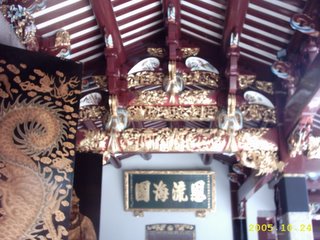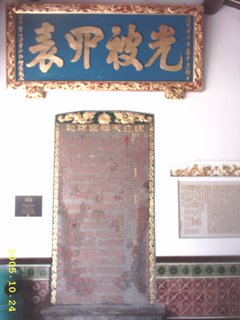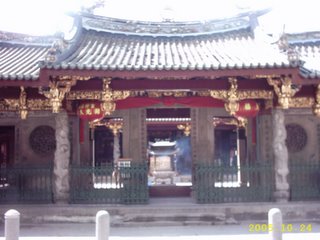 Claimed to be the oldest and most important Hokkien temple in Singapore, this place of worship houses a number of relics, some reputed to be several centuries old, which have been brought over from China. It was gazetted as a national monument on 6 July 1973. Thian Hock Keng has undergone several renovations, the latest in 1998.
Claimed to be the oldest and most important Hokkien temple in Singapore, this place of worship houses a number of relics, some reputed to be several centuries old, which have been brought over from China. It was gazetted as a national monument on 6 July 1973. Thian Hock Keng has undergone several renovations, the latest in 1998.Completed in 1842 to replace a simple joss-house built some two decades earlier, not a single nail had been used in the construction, not even for its pagoda-shaped roofs. Instead the entire structure is supported by iron-wood posts and granite imported from China. The temple boasts of gilded carvings, tile roofs adorned with dragons and phoenixes, intricate sculptures from China, pretty blue porcelain tiles from the Netherlands, and cast-iron railings from Scotland. The early builders understood well the significance shapes play in temple architecture, and the Thian Hock Keng is a fine example. It has windows that are circular to symbolize heaven, square to symbolize the earth, and tiles which were meticulously laid out either in square patterns to symbolize the mouth, implying that one would never go hungry here, or in an upside down “V” pattern, symbolizing “ren”, the Chinese word for “men”, to suggest that one can regard this place as a sanctuary.

According to Geraldene Lowe in her book, “Chinatown Memories”, some materials used in the construction of the temple had been salvaged from junks plying between China and Singapore. Crockery broken during the rough journey were recycled too, turning up as mosaic pieces adorning the feathers of birds, petals of flowers and on other ornaments dotted throughout the temple.

Tan Tock Seng who contributed $3,0474.76, then a princely sum, for the temple building fund, topped the donor’s list. This information, along with that on the founding of the temple, are inscribed on plaques installed near the main entrance.
Guarding the majestic entrance to the temple are two stone lions. The female one holds a cup representing fertility while her male counterpart holds a ball, symbolizing abundance. Before entering the temple, a devotee has to cross a rather high threshold. This is deliberate. For one thing, it forces him to cast his sight downward, an expression of humility, as is expected when one enters a sacred building. Another purpose is to keep out wandering malevolent spirits – it is believed that ghosts shuffle when they move, so this threshold was placed to trip them up. The more pragmatic would explain that the threshold is keep flood waters at bay, since the area was susceptible to flooding.

One of the main deities in the Thian Hock Keng is Mazu (Goddess of Seafarers/Patron of Sailors). She is accompanied by her two sentinels, one with vision that spans 1,000 miles and another gifted with ears that could hear 1,000 miles away. Years before the land in front of Telok Ayer basin was reclaimed and named Collyer Quay, Hokkien immigrants would step out of their junks somewhere behind Telok Ayer Street, possibly very close to the Ying Fo Kuan, a Hakka Association Hall established in 1822. Fresh off the boat, these chaps would invariably head for a “joss house” to give thanks to the Gods for their safe arrival after a long journey across the treacherous South China Sea. That was how the joss house at Telok Ayer Street, precursor to the Thian Hock Keng, came to be erected.
An exquisite likeness of Mazu was said to have been brought to Singapore from Amoy (Xiamen) in 1840. An elaborate procession was held that day as the Goddess made her way from the waterfront to grace the then newly-completed temple in Telok Ayer Street. Several other deities are worshipped in the Thian Hock Keng, among them Confucius, the God of Wealth, the God of Health, the Goddess of Mercy, the Sun God and the Moon Goddess.

Two pagodas flanked the Thian Hock Keng – the one to the right, nearer to Boon Tat Street, is said to contain ancestral tablets of a group of Hokkiens from the same village in Amoy who had landed in Malacca. Those men continued to keep in touch with each other after settling in Singapore. Today some of their male descendants still carry on this tradition of holding reunions, opening up the shrine on the eve of Chap Goh Meh, Cheng Beng Festival and Hungry Ghost Festival. The other pagoda nearer to Amoy Street had been the kindergarten section of a girl’s school in the 1970s. It has now been converted into a café cum souvenir shop. The two pagodas have very striking roofs – they are red and shaped like a gourd. The significance of the gourd-shape is explained at length in Geraldene’s book. She wrote that before glass and porcelain had been invented, medicines were stored in gourds which had been left to dry. As such, gourd-shaped talismans worn on the body were believed to have the power to protect its wearer from diabolical forces out to wreak havoc on one’s health. Eventually some temple roofs took on this shape too – to indicate that there is a herbalist or physician on site. Perched high above other buildings, and with such a striking colour, it was easy for people to spot such a temple.
Thian Hock Keng is managed by the Hokkien Huay Kuan (Association for the Hokkien dialect group), located just across the road. Originally, this dialect association was housed in the temple itself. Tan Tock Seng’s son, Kim Cheng, was the association’s pioneer President. During his tenure, the temple cum huay kuan was the focal point of the Hokkien community, serving not only as a place of worship, but also as a meeting place for the community, a recruitment centre for coolies as well as a safe-house from unruly elements.
Location:
158 Telok Ayer Street
Singapore 068613
Tel: 6423-4616; 6222-2651
3 comments:
Good work, please also visit places of worship & devotion in Sarawak -> www.charcoal.netmyne.com
Would love to. If you could share with us the temples in Sarawak, perhaps, we could visit and learn more about it. (^^)
Wow, just visited your site. Great stuff! Allow me to link this blog to your site!
Post a Comment